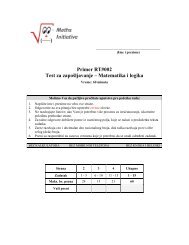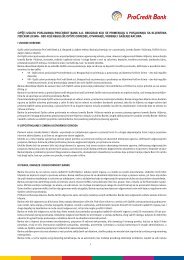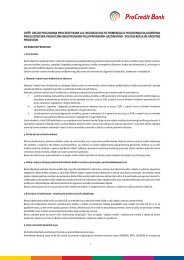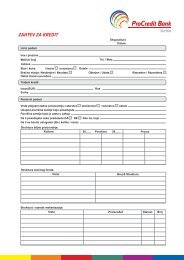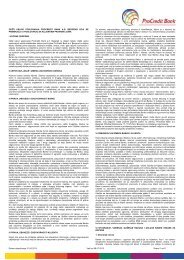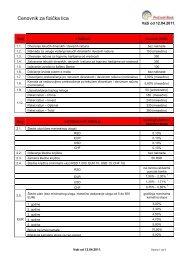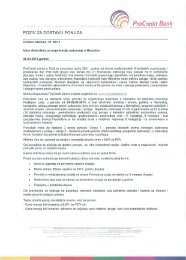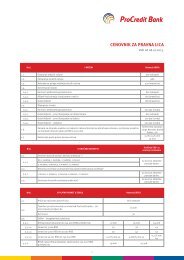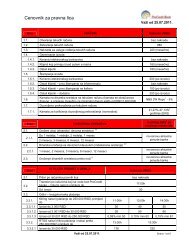Annual Report 2010 - ProCredit Bank
Annual Report 2010 - ProCredit Bank
Annual Report 2010 - ProCredit Bank
- No tags were found...
Create successful ePaper yourself
Turn your PDF publications into a flip-book with our unique Google optimized e-Paper software.
68<br />
<strong>Annual</strong> <strong>Report</strong> <strong>2010</strong><br />
continued EUR USD Other Total foreign Local Total<br />
currencies currencies Currency<br />
31 December 2009<br />
Total assets 49,991,260 556,127 135,165 50,682,552 15,703,122 66,385,674<br />
Total liabilities and equity 49,799,817 659,930 69,840 50,529,587 15,856,087 66,385,674<br />
Net on-balance sheet position 191,443 (103,803) 65,325 152,965 (152,965) –<br />
Credit commitments (Note 34) – – – – 1,884,115 1,884,115<br />
Following table provides overview of sensitivity analysis of the exposure<br />
to currency risk under the assumption of the change in local<br />
currency exchange rate by 15%:<br />
Open currency Effect of 15 % Effect of 15%<br />
position based on position balance depreciation of RSD to appreciation of RSD to<br />
sheet data on 31 December Open open Currency currency Position position Open open Currency currency Position position<br />
2009 <strong>2010</strong> 2008 2009 2009 <strong>2010</strong> 2008 2009 2009 <strong>2010</strong> 2008 2009<br />
USD (476,985) (103,803) (103,308) 384,652 (71,548) (15,570) (15,570) 57,698 71,548 15,570 (57,698) 15,570<br />
EUR 1,635,219 191,443 191,443 3,064 245,283 28,716 28,716 460 (245,283) (28,716) (28,716) (460)<br />
Other Currencies (15,787) 65,325 65,325 5,186 (2,368) 9,799 9,799 778 (9,799) 2,368 (9,799) (778)<br />
Having in mind the currency structure of the balance sheet the<br />
appreciation of the local currency by 15% would result in negative<br />
effect profit of RSD 171,367 thousand (2009: negative effect<br />
of 22,954 thousand). In case of depreciation of the local currency<br />
by 15% positive effect on profit would be RSD 171,367 thousand<br />
(2009: positive effect of 22,954 thousand).<br />
C.2. Interest rate risk<br />
The Group takes on exposure to the effects of fluctuations in the<br />
prevailing levels of market interest rates on its financial position<br />
and cash flows. Interest rates may increase or decrease as a result<br />
of such changes and may create negative effects to the Groups capital<br />
and/or income. Interest rates are based on market rates which<br />
the Group reprises and reassesses regularly.<br />
Risk management activities are aimed at optimizing net interest income,<br />
given market interest rate levels consistent with the Group’s<br />
business strategies. In managing maturity structure, senior management<br />
considers among others:<br />
• Macro- and microeconomic forecasts,<br />
• Forecasts in liquidity conditions and<br />
• The anticipated trends in interest rates.<br />
Interest rate risk presented in gaps between remaining maturities<br />
of assets and liabilities with fixed interest rate is managed by balancing<br />
the structure of loans and advances to customers with due<br />
to customers and other types of short- and long-term borrowings.<br />
Interest rate risk presented in gaps between maturities of reprising<br />
of taken long term loans linked to floating rates, and reprising of<br />
loans disbursed at floating interest rates, is prudently hedged with<br />
Fixed-for-Floating Interest Rate Swap. As of 31 December <strong>2010</strong> the<br />
Group had Interest Rate Swap in the outstanding notional amount<br />
of EUR 1.938 million (31 December 2009: EUR 2.625 million).<br />
The table below summarizes the Group’s exposure to interest rate<br />
risks. Included in the table are the Group’s assets and liabilities at<br />
carrying amounts, categorized by the earlier of contractual reprising<br />
or maturity dates.



